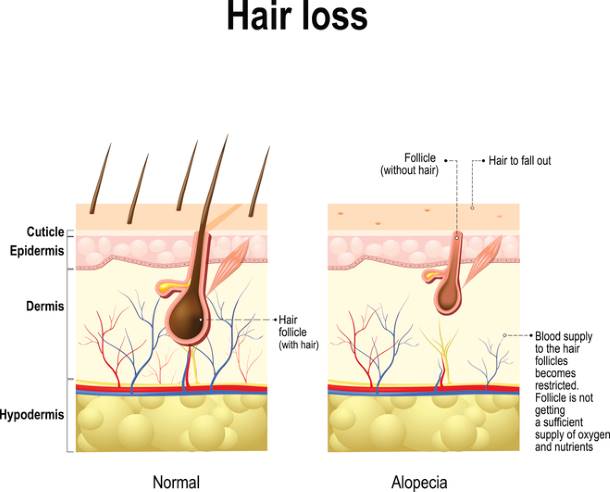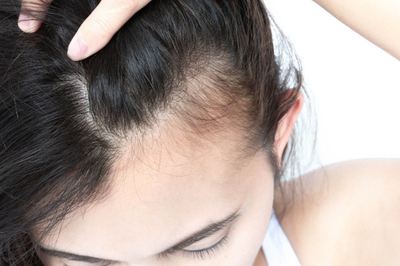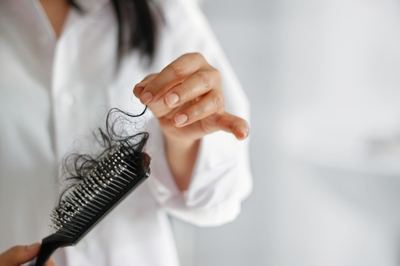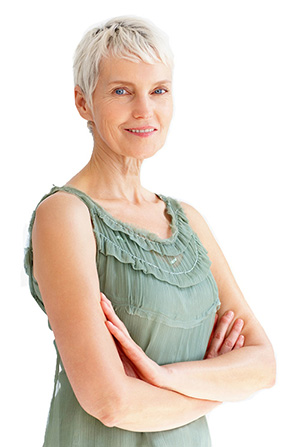 When you think of hair loss, you usually think of it as a male problem. But, women, too, especially as they approach and enter their menopausal years, can struggle with thinning hair.
When you think of hair loss, you usually think of it as a male problem. But, women, too, especially as they approach and enter their menopausal years, can struggle with thinning hair.
This can be an even greater problem for women. Whereas baldness is entirely socially acceptable for men – sometimes even thought of as sexy- hair loss in women is, for the most part, considered unattractive and can lead to serious self-esteem issues and social isolation for females.
Hair loss in all humans, including women, is normal. We constantly shed hair. It’s when more hair is lost than can be replaced is when it results in thinning hair and hair loss.
There is not one single cause of hair loss in women. Anything from your diet to the way you wear your hair, to medications such as chemotherapy, can result in hair loss in women. But the most common reason for thinning hair in women, particularly in women over 40, is age-related hormone loss.
What Are the Three Patterns of Female Hair Loss?
There are three types of “patterns” of hair loss in women. These are: anagen effluvium, telogen effluvium and FPHL.
- Anagen effluvium: This is the kind of hair loss or thinning hair in women caused by medications or drugs that are toxic to the hair follicles, such as chemotherapy.
- Telogen effluvium: This is common age-related hair loss which occurs when more hair follicles reach the “telogen phase,” which is the stage where hair falls out, then can be replaced by new, healthy hair follicles.
- Androgenetic alopecia/ female pattern hair loss (FPHL): This type is the most common type of hair loss in women, where thinning occurs on the top of the scalp and sides of the head. This hair loss is hormone related, and usually occurs due to the age-related depletion of hormones that occur in the menopausal years. This is also the type of hair loss that can be effectively treated and reversed with hormone replacement therapies.

What Causes Hair Loss In Women?
Hair loss in women is more common than you may think. It has been estimated that more than 50% of all women will experience hair loss noticeable enough to cause them distress. The most common cause of thinning hair and baldness in women is female-pattern hair loss (FPHL), which affects about one in every three women, which is about 30 million women in the United States.
There are many causes of hair loss in women, and each of the above three types or patterns of female hair loss can have its own specific causes.
General causes of hair loss in women include:
- Hairstyle: Tight hairstyles like cornrows, braids, or ponytails, can cause hair loss known as traction alopecia.
- Certain vitamin deficiencies.
- Dietary issues.
- Overuse of hair and scalp products with harsh chemicals.
Causes of anagen effluvium hair loss:
- Toxic substances, including chemotherapy, radiation therapy, and some medications.
Causes of telogen effluvium hair loss:
- Extreme physical stress or shock to your body, such as injury or pregnancy.
Extreme stress.
An abnormal thyroid.
Hormonal issues.
Causes of female pattern hair loss:
- Genetic dispensation.
- Aging and the hormonal changes due to menopause.
How are a Woman’s HGH Levels Connected to Hair Loss?
 Human growth hormone is essential for the growth and replacement of every cell in the body, which includes hair follicles. However, HGH plays a specific role in hair growth.
Human growth hormone is essential for the growth and replacement of every cell in the body, which includes hair follicles. However, HGH plays a specific role in hair growth.
To understand how HGH therapy can help reverse the signs of hair loss in women, we must first take a closer look at how hair grows.
Hair growth begins with specialized cells called “keratinocytes,” which produce keratin. These cells reside in a bulb that forms at the base of a hair follicle, and it is within this hair bulb that the keratinocytes live, grow and produce the keratin that stimulates the growth of the hair shaft. Hormones support this process, one of the most important of which is HGH.
As women age, their HGH levels drop along with those of other hormones. As HGH levels diminish, this process slows, and more hair is lost than can be replaced, with healthy, strong, and fully pigmented hair. This is the main reason hair thins and turns gray as women age.
HGH therapy can help to slow, or even reverse hair loss in women.
What are the Signs of Hair Loss in Women?
As in men, hair loss in women can be quite gradual. In females, usually, one of the first signs of hair loss they notice is often a widening part or less fullness to their ponytail.
Other signs of hair loss in women include:
- Gradual thinning of the hair on your head
- A bald spot that increases
- Receding hairline that slowly becomes more apparent
- Widening part
- Thinner ponytail
Can HGH Therapy Help Treat and Prevent Female Hair Loss?
HGH is critical to the health, growth, and repair of hair follicles. HGH stimulates hair growth in two very important ways. It supports the health and function of the cells in the hair bulb responsible for the production of keratin and collagen, that are necessary for strong, healthy hair. HGH also helps to stimulate blood flow to the scalp and the hair follicles.
Women lose HGH as they age, just as they do estrogen and other female hormones. As HGH is essential for healthy hair growth, HGH therapy can help slow or reverse age-related hair loss in women, the most common cause of female pattern hair loss.
Other Remedies for Hair Loss in Women
 If your female pattern hair loss is hormonal and not genetic, in addition to hormone replacement therapy, there are some other actions women can take to slow or prevent it.
If your female pattern hair loss is hormonal and not genetic, in addition to hormone replacement therapy, there are some other actions women can take to slow or prevent it.
Reduction of stress is a good way to slow hormonal hair loss in women. Employing stress reduction techniques such as meditation, yoga, deep breathing, Tai Chi, or Qigong, and getting regular exercise could reduce your cortisol levels and help prevent hormone-related thinning hair in women.
Eating a healthier diet is also not only good for you overall, but could help minimize hair loss in women. Adding healthy proteins to your diet and foods rich in Omega-3 fatty acids and fresh fruits and vegetables are great for healthier hair. If you’re trying to prevent female pattern baldness, you can take vitamins such as iron, biotin, vitamin D, vitamin C, and zinc.
Surgical options such as hair transplantation can be an effective way to reverse hair loss in women, but such procedures are invasive, time-consuming, and quite expensive.
Conclusion
Hormone replacement therapy, and in particular adding HGH to the HRT regimen for perimenopausal and menopausal women, has been found to be quite effective in reversing hair loss and thinning hair in older women.
Studies have found that HGH can minimize hair loss and improve hair growth in women in four essential ways:
- The primary benefit of HGH for hair growth begins is that it renews and replaces dead and dying keratinocytes with healthy ones.
- HGH therapy has been shown to increase blood flow to the hair follicles, which helps to keep newly growing hair, thanks to renewed keratinocyte activity, young and healthier longer.
- The proteins which make up HGH contain the amino acids necessary to form keratin which is essential for strong, healthy hair.
- HGH not only helps to reverse hair loss in women, but it can also help retain pigment and help prevent gray hair in women.
Our female patients who have been found to be experiencing hair loss due to low HGH or hormonal imbalance have reported an overall improvement in hair thickness and quality, as well as a return of natural color after just six months of HGH therapy!


